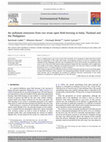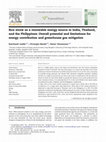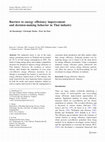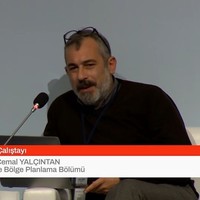Papers by Christoph Menke

In Germany buildings that undergo major renovation need to include the use of renewable energy in... more In Germany buildings that undergo major renovation need to include the use of renewable energy in their energy system. Under normal circumstances around 15% of the total building energy demand shall be deployed, e.g., from solar energy. In the last three years several large-scale solar thermal systems for student dormitories were designed and installed in Trier (Germany), in close cooperation with the solar centre of excellence of the university. The solar systems are operated by the management of the student dormitories. Their system performance can be monitored online. First, the paper describes the selected system concepts and the required approval process for getting state subsidies, then secondly the approach how to realize them among others with the help of local handicapped people, who manufacture collectors with solar keymark label. Thirdly it describes the system operation, the monitoring process and finally the way how such systems can be optimized using online monitoring ...
Energy Efficiency, 2010
The cement industry is one of the most energy-consuming industries in Thailand, with high associa... more The cement industry is one of the most energy-consuming industries in Thailand, with high associated carbon dioxide (CO 2 ) emissions. The cement sector accounted for about 20.6 million tonnes of CO 2 emissions in 2005. The fuel intensity of the Thai cement industry was about 3.11 gigajoules (GJ)/tonne cement; the electricity intensity was about 94.3 kWh/ tonne cement, and the total primary energy intensity was about 4.09 GJ/tonne cement in 2005 with the clinker to cement ratio of around 82%. In this study, the potential application of 47 energy-efficiency measures is assessed for the Thai cement industry.
Energy, 2009
Using the results of a comprehensive data analysis of final energy consumption in industry and co... more Using the results of a comprehensive data analysis of final energy consumption in industry and commercial buildings, the assessment has been made of the potential for gradual implementation of cogeneration plants in these facilities. In doing so, plans for the expansion of the ...

This research work contributes to enhance scientific knowledge for estimating air pollutant emiss... more This research work contributes to enhance scientific knowledge for estimating air pollutant emissions from open burning of crop residues and improve emission results accuracy. a b s t r a c t Rice is a widely grown crop in Asia. China (30%) and India (21%) contribute to about half of the world's total rice production. In this study, three major rice-producing countries in Asia are considered, India, Thailand and the Philippines (the later two contributing 4% and 2% of the world's rice production). Rice straw is one of the main field based residues produced along with this commodity and its applications vary widely in the region. Although rice production practises vary from one country to another, open burning of straw is a common practice in these countries. In this study, an approach was followed aiming at (a) determining the quantity of rice straw being subject to open field burning in those countries, (b) congregating pollutant specific emissions factors for rice straw burning, and (c) quantifying the resulting air pollutant emissions. Uncertainties in the results obtained as compared to a global approach are also discussed.
... This paper analyzes two typical examples of applying cogeneration in public buildings, certai... more ... This paper analyzes two typical examples of applying cogeneration in public buildings, certainly very typical for Thailand and also for many other ... The building complex is comprised of offices, restaurants, shops with the main office buildings open from 8:00 AM to 5:00 PM from ...

Energy Policy, 2000
In 1995, industry accounted for 41% of global energy use. Although the e$ciency of industrial pro... more In 1995, industry accounted for 41% of global energy use. Although the e$ciency of industrial processes has increased greatly during the past decades, energy e$ciency improvements remain the major opportunity to reduce CO emissions. Industrialisation may a!ect the environment adversely, stressing the need for transfer of cleaner technologies to developing countries. A review of trends, barriers and opportunities for technology transfer is presented. Technology transfer is a process involving assessment, agreement, implementation, evaluation and adaptation, and repetition. Institutional barriers and policies in#uence the transaction process, as well as the e$ciency of the transfer process, in particular in the adaptation and repetition stages of the technology transfer process. Investments in industrial technology are dominated by the private sector. In industry, energy e$ciency is often the result of investments in modern equipment, stressing the importance and need for environmentally sound and long-term investment policies. The interactive and dynamic character of technology transfer stresses the need for innovative and #exible approaches, through partnerships between various stakeholders. Adaptation of technology to local conditions is essential, but practices vary widely. Countries that spend on average more on adaptation, seem to be more successful in technology transfer, hence successful technology transfer depends on transfer of technological capabilities. Published by Elsevier Science Ltd.

Biomass and Bioenergy, 2009
Energy GIS Field burning GHG emissions a b s t r a c t Rice is a widely grown crop in the South a... more Energy GIS Field burning GHG emissions a b s t r a c t Rice is a widely grown crop in the South and South-East Asia that leaves substantial quantity of straw in the field. The aim of this paper is to assess the quantity of rice straw produced, estimate Greenhouse Gas (GHG) emissions based on its current uses, and assess its possible energy potential and related GHG emissions mitigation potential. Updated statistics on rough rice production are used in this study in combination with the literature values on Straw-to-Grain Ratio (SGR) to quantify the amount of rice straw produced in the three countries of focus. It is estimated that 97.19, 21.86, and 10.68 Mt of rice straw residue are produced in India, Thailand, and the Philippines, respectively. In India, 23% of rice straw residue produced is surplus and is either left in the field as uncollected or to a large extent open-field burnt. About 48% of this residue produced is subjected to open-field burning in Thailand, and in the Philippines it is 95%. The GHG emissions contribution through open-field burning of rice straw in India, Thailand, and the Philippines are 0.05%, 0.18%, and 0.56%, and the mitigated GHG emissions when generated electricity is used would be 0.75%, 1.81%, and 4.31%, respectively, when compared to the total country GHG emissions. (C. Menke), r.wassmann@cgiar.org (R. Wassmann). 1 Tel.: þ66 (0) 8 3993 7478 (mobile). 2 Tel.: þ63 (0) 2 580 5600x2737; fax: þ63 (0) 2 580 5699. A v a i l a b l e a t w w w . s c i e n c e d i r e c t . c o m h t t p : / / w w w . e l s e v i e r . c o m / l o c a t e / b i o m b i o e 0961-9534/$ -see front matter ª b i o m a s s a n d b i o e n e r g y 3 3 ( 2 0 0 9 ) 1 5 3 2 -1 5 4 6

In 1995, industry accounted for 41% of global energy use. Although the e$ciency of industrial pro... more In 1995, industry accounted for 41% of global energy use. Although the e$ciency of industrial processes has increased greatly during the past decades, energy e$ciency improvements remain the major opportunity to reduce CO emissions. Industrialisation may a!ect the environment adversely, stressing the need for transfer of cleaner technologies to developing countries. A review of trends, barriers and opportunities for technology transfer is presented. Technology transfer is a process involving assessment, agreement, implementation, evaluation and adaptation, and repetition. Institutional barriers and policies in#uence the transaction process, as well as the e$ciency of the transfer process, in particular in the adaptation and repetition stages of the technology transfer process. Investments in industrial technology are dominated by the private sector. In industry, energy e$ciency is often the result of investments in modern equipment, stressing the importance and need for environmentally sound and long-term investment policies. The interactive and dynamic character of technology transfer stresses the need for innovative and #exible approaches, through partnerships between various stakeholders. Adaptation of technology to local conditions is essential, but practices vary widely. Countries that spend on average more on adaptation, seem to be more successful in technology transfer, hence successful technology transfer depends on transfer of technological capabilities. Published by Elsevier Science Ltd.

Energy Efficiency, 2010
The industrial sector is one of the main energy consuming sectors in Thailand and accounted for 3... more The industrial sector is one of the main energy consuming sectors in Thailand and accounted for 36.7% of total energy consumption in 2005. The trend of rising energy prices and tougher competition increases the demand to improve energy efficiency in Thai industry. However, the existence of various barriers often hinders the realization of even some cost-effective energy efficiency measures. In an attempt to investigate key barriers to and drivers for energy efficiency improvement in Thai industry, this study found that the most important barrier expressed by both the textile and cement industries studied as well as experts interviewed is that the management is concerned about production and other matters rather than energy efficiency. Reducing product cost by reducing energy cost is found to be the main driver for energy efficiency investment. Using a conceptual industrial energy efficiency policy framework this study shows how various energy efficiency policies can affect the process of decision-making for and investment in energy efficiency in industry.
Environmental Pollution, 2009
This research work contributes to enhance scientific knowledge for estimating air pollutant emiss... more This research work contributes to enhance scientific knowledge for estimating air pollutant emissions from open burning of crop residues and improve emission results accuracy.











Uploads
Papers by Christoph Menke